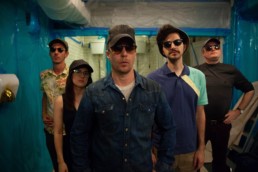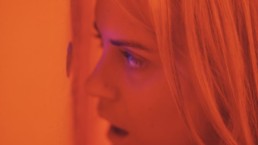'The Man Who Killed Don Quixote' Review: The Mad Gilliam Dreamer
When discussing the large range of dreamers, one could argue that director Terry Gilliam and Don Quixote are not listed far apart. For both of them, madness and dreaming seem to be one and the same, and their actions result in the gleeful entertainment for a reading or movie-going audience. The major difference being Gilliam’s clear awareness of his on-lookers’ expectations of madness and his masterful ability to play a self-referential magic trick, whilst hurling his protagonist and audiences narrative twists through differing character perspectives, before bouncing you through the fourth wall. This can be as subtle as a character knocking subtitles off the screen to show familiarity with their scene partner, or as drastic as inexplicably thrusting a protagonist head first in and out of surreal dreams that adopt another character’s impossible delirium. The result can be dizzying and confusing, but when on his game, Gilliam leaves a viewer feeling slightly crazy and asking things like; what in their world is real? And does that really matter?
The Man Who Killed Don Quixote presents an old man (Jonathan Pryce) fully immersed in the delusional fantasy of being the embodiment of the legendary Don Quixote of Spanish folklore, and a jaded director (Adam Driver) existentially searching for meaning before physically stumbling upon the tragedy he left behind when he was last there, shooting a film. The two characters are cosmically linked, in that through Toby’s (Driver) direction, Javier (Pryce) found his own personal “Don Quixote Madness,” giving the manifestation life.
However, it was also Toby who eventually claims the film’s title spot, reacting to his own hallucinations and accidentally killing his Don Quixote. In a fit of rage and grief, Toby calls out that the brave knight said he could never die, and fate seems to answer. The next scene, Toby displays his own personification of the mad defender of chivalry before riding into the sunset with a new “Sancho Panza” and code of values.
There are many parallels between Toby’s journey from lost arrogance to morally directed lunacy, and Gilliam’s long struggle to make this film. The project took nearly 30 years from conception to release, and so the idea of returning to ideas and locations where you’ve filmed and touched the lives of people is a strong correlation. As with anything, failed attempts can lead to frustration and Gilliam and his team briefly began shooting once in 2000. And in 2009, after a 9-year suspension, he continued writing and tweaking the screenplay with Tony Grisoni, who stated that they’d been re-writing the script on average, “twice a year, maybe more” since then. The process of revisiting ideas, some of which had failed or had unforeseen results, can be maddening especially when spread over three decades. Toby’s search for purpose and meaning in the insanity-stricken Javier’s charmingly righteous Don Quixote seems to mirror Gilliam’s pursuit of achieving a nearly impossible dream; to present his interpretation of beautiful innocence and chivalry that lies within one dreamer’s fantasy.
This theme of the deceptively wise mad-man has been present in many of Gilliam’s films. To name a few, The Adventures of Baron Munchausen (1989), The Fisher King (1991), Twelve Monkeys (1996) and Fear and Loathing in Las Vegas (1998), all have stories that dip into and often align with perspectives of characters that are declared insane within the world of the film. This suggests that the idea of higher morality and greater humanity can rise-above, subvert, or at the least remain independent of what society deems sane or logical.
In The Man Who Killed Don Quixote, Toby recognizes his sins when reflected back at him by the attendees of a costume party. Their cynicism, selfishness and cruel indifference to Javier’s mental affliction shame Toby and allows for him to embrace the magical and moral calling that Javier presented to him as Don Quixote. It appears more important to Gilliam to be outside the realm of social sanity than to sacrifice one’s moral compass for the sake of conformity in an immoral world.
The Man Who Killed Don Quixote opens at Arena Cinelounge this Friday.
'Blue Iguana' Review: A Cross-Genre Exploration of Crime and Comedy
Comedic-crime films and un-heroes have been a staple of Hollywood cinema since its early induction with loveable tramps and screwballs such as Charlie Chaplin and Buster Keaton.
Continuing the expansion of this cross-genre cinema, Hadi Hajaig’s Blue Iguana playfully dives into a fantastic criminal setting of a vibrant and violent London, lead by three main protagonists, all of which are a delightful blur of archetypes and new spins on the genre. It’s a fun, action-comedy heist film with a happy ending and a few darkly comedic bumps and twists along the way. These days, it’s refreshing to watch a film that provides an entertaining escape and doesn’t take itself too seriously, without baking the intelligence out of the plot.
Sam Rockwell and Ben Schwartz provide a wonderful comedic duo as the smooth n’ cool thief, Eddie (Rockwell) and the high energy of hilarious, fast-talking Paul (Schwartz). Their success is derived from their differences in comparison to their character foil, the wanna-be alpha male antagonist, Deacon (Peter Ferdinando). Deacon's daddy-issues and mullet are brilliant representations of his outdated views of masculinity and eventually, his rage and macho manners lead to his downfall. But as Eddie reads comic books and Paul is uncomfortable with violence and wears pastels, they subvert the expectation of the dark crime world, allowing for the wheels to come loose and the comedy to ensue. One could argue that Eddie’s romantic side is what attracts him to comics and allows for him to hold on to his noble-ish self-image, while Paul’s neurotic and non-violent nature allows him to observe alternative solutions to the trials and tribulations that face the duo and the gang of thieves (both of which are essential to the ebb and flow of the narrative journey).
Just as 'Baby Driver' and 'Guardians of the Galaxy' has a steady string of sick tunes, 'Blue Iguana' has a soundtrack of similar quality, which has become a very good sign for a summer film.
However, the plot’s true motivations, as well as the main source of pathos and empathy throughout the film, are powered by the underestimated and incredibly intelligent lawyer, Katherine (Phoebe Fox). With Katherine, writer/director Hajaig does a play on the typical femme-fatale character. He gives the character insecurities and reveals her good intentions early on, giving the audience a different perspective of the typical crime film. As a director, Hajaig makes a choice to pay respect to the emotional journey Katherine is going through with her outstanding debt to a gangster, her feelings of guilt, and a developing romantic entanglement with Eddie. While the romance can be a little cliché, it is a satisfying conclusion for two moral characters struggling with the lonely world.
The reason the heist film still exists today is that it provides an escape for which audiences can live vicariously through characters. There are many film theorists that have discussed the idea of cinema as being a way for people to live their secret fantasies in a care-free environment. Crime films present idolized and glamorized stories for which law and order often abide chaos, destruction and violence with very little consequence for the characters- if they survive, of course. What’s most important for this genre to remain relevant are stories with different spins, unique twists, and these days, a KILLER soundtrack. Just as Baby Driver and Guardians of the Galaxy were able to take over summer music scenes with a steady string of sick tunes, Blue Iguana has a soundtrack of similar quality, which has become a very good sign for a summer film. So, if you like good tunes, times, and crimes, you may enjoy Hadi Hajaig’s Blue Iguana, in theatres August 24th.
'Blue Iguana' is not rated. 100 minutes. Opening this Friday at the Laemmle Monica Film Center.
'Straight Into A Storm' Review: Why You Should Love Deer Tick
What I dig about a well-done rock doc is the intimate look into the often volatile growth and progression of a group of friends and colleagues, each with their own motivations, goals, and self-perceptions.
Straight Into A Storm gives a close personal look into the development of eccentric singer-songwriter, John McCauley and other various members of Deer Tick over the last decade. As the band celebrates its 10th anniversary and the new release of Deer Tick Vol. 1 and Deer Tick Vol. 2, director William Miller thoughtfully sews together home and on-the-road footage, concert footage, and various interviews to create a story of triumph within the realms of cult fame, personal growth, and professional respect amongst their musical peers and community.
The film testifies to the prodigious musical talent of John McCauley, watching him grow from a teenager performing in living rooms and apartments, to large stadiums and events including Coachella and South by Southwest. But no matter the venue, McCauley has always been able to possess his audience with his varied performances. Varied in the sense that in one song, his grating voice might take over as he jumps into the crowd, and the next, he knocks everyone out with a calm, heartfelt, Dylan-esque acoustic number. The only way the band is not lost behind his charisma, especially in his early days of drugs, drinking, and nudity on stage is by being just as talented and with as much range as him. Luckily, he just happened to be friends with a bunch of talented guys.
All of the band members explain a sense of comfort in regards to their membership in Deer Tick. Christopher Dale Ryan was still able to pursue his higher-level musical ambitions while always returning to the band. His brother, Dennis and lead guitarist, Ian Patrick O’Neil were able to bring their own songwriting abilities to the band to pair with McCauley’s. As the band went through different players, eventually settling on star keyboardist Rob B. Crowell, their interviews in the documentary show them baring great respect for their former bandmates, far from any resentment or bitterness. This has always been a band of friends from its first conception in a little neighborhood in Rhode Island. As for the 4 years since they released their last album, McCauley comments jokingly that “they just kind of got comfortable away from each other.” It seems they had grown so much together that even the silence is comfortable, and there is something admirable in such an enduring friendship.
Not only is this a look at Deer Tick, the indie folk-rock band, it is also a look into how to successfully grow up as a musician in middle America and remain sane...
As far as cinematic storytelling, Miller and co-editor Chris Lechler have a few strokes of genius. They brilliantly cut together multiple performances of the bands’ songs over many years, creating a juxtaposition of the band’s growth over time. Struggles with drugs, the development of styles, and stage performances of various levels of playful anarchy and quiet tranquility are easily offered up for audience observation and allow for unique insight.
While it might be fair to say that not all audience members will be familiar with Deer Tick’s story going into the film, after seeing Straight Into A Storm, they will have gained a perspective that has previously been reserved for the band’s close friends and lifelong groupies. William Miller has proven himself to be a gifted rock documentary filmmaker with a keen eye and desire to share the stories of great musicians. Not only is this a look at Deer Tick, the indie folk-rock band, it is also a look into how to successfully grow up as a musician in middle America and remain sane; how to allow yourself to change with life experiences while holding close the traits and values that are most important to who you are. It’s a touching story of a fun bunch of talented friends fronted by a gracious, wacky prodigy, who credits his peers for his success. And whose peers turn around and toss the credit back to his enormous stage presence and artistic ability. Hopefully, the journey of musical progression will continue for a group that deserves much success.
'Straight Into A Storm' is not rated. 110 minutes.
'It Came From the Desert' Review: A European Post-Modern Revue of American Cross-Genre Cinema
There are many levels to the dissection, break down and analysis of a film.
From source material to shooting location and from cast to crew, everything should be taken into account when attempting to understand the piece. This is especially true if the filmmaker and other elements of the production are from different cultural backgrounds than the content that they attempt to tackle. Finnish filmmaker Marko Mäkilaakso’s It Came From the Desert takes on two staples of American pop culture– one being the monster genre, and the second is the video game-to-screen adaptation. Amidst the slapstick and pulpy, bloody humor lies a deceptively introspective look into a European director and his team’s perspective on the American youth culture as portrayed in the action-horror-comedy genre.
It Came From the Desert is a postmodern buddy-comedy fueled by motocross and monster killin’ based off of a computer game by Cinemaware. It plays out in front of a dreamlike desert landscape (beautifully shot in Almeria, Spain, and Turku, Finland), and pays homage to a 1989 cult-classic American video game and 1950s "B" movies. In the spirit of these multiple eras in reference, the film takes on a strange hybrid of American cinema pastiche.
Right off the starting line, the narrative mixes dirt-biking rivalries, common in the Grindhouse action films of the seventies, with the “red cup” style party comedies of nineties, assisted by horny teenage angst and the current day, hipster “nostalgic meets biker-bro” fashion. The game's iconic Monster Ants make the transition from the original source material to the film’s present-day storyline relatively smooth by maintaining a relatable visual framework for the viewer. Mäkilaakso and his team are able to explore their brand of self-referential humor in each of these cultural tropes without compromising the film’s fun, visceral focus.
Keeping up with the current post-modern trends, 'It Came From the Desert' provides a nostalgic vibe that remains respectful to its computer game roots.
It is also important to consider that the principal cast is primarily composed of young English talent, making their performances of such archetypal American antiheroes a stylized parody in and of themselves. Harry-Lister Smith, Alex Mills, Vanessa Grasse and the rest of the cast give their best meta interpretations of American youth as depicted in Hollywood monster cinema, each bringing their metaphorical jigsaw pieces of sex, alcohol, bad decisions and eventual triumphant comradery to their traditional character arcs.
Mäkilaakso, along with the director of photography, Juge Heikkilä, and the production designer, renowned Kari Kankaanpää, all hail from Finland and seem to be tossing their own self-referential fuel on the fire. The gorgeous stylistic lighting of the desert, fifties-esque military facility and thematic feel of the film are just a few tips of the hat to the project’s muses. While the mixing of the present-day narrative with the aforementioned “almost-retro” wardrobe, along with the party behavior and setting, serve as interesting depictions of American cinema’s portrayal of youth culture through a contemporary European lense. Not to say that this was or was not Mäkilaakso's intention, as the film is really more in it for the fun than the artistic statement. However, their approaches to the depiction of certain social aspects of the culture are interesting bi-products of their satirical take on American cinema.
The action-horror-comedy genre is a difficult field to navigate, with many fires to tend. In this case, the film's over-the-top choices blend well with the gory, yet very lighthearted, approach to the content. Keeping up with the current post-modern trends, It Came From the Desert provides an easy to digest (though I wouldn’t recommend eating while watching) nostalgic vibe that remains respectful to its concept’s roots. Like its source material, it has the potential to find its niche audience.
'It Came From the Desert' is not rated. 90 minutes. Available for streaming on May 29th, pre-order here: http://radi.al/ItCameFromTheDe
'Aardvark' Review: The Psychology of Redemption
It is a common practice in independent filmmaking for a director to tap on the shoulders of their friends and invite them to collaborate on something they believe in.
In this method, those involved can often find a certain level of comfort amongst each other, usually resulting in strong performances and quite capable directing. Aardvark, director-writer Brian Shoaf’s darkly mysterious and touching drama starring close friend and producer Zachary Quinto, his friend Jenny Slate, and her old friend John Hamm, pays testament to this formula and allows for this new director to play with themes that ring true on a subconscious and primal level.
The film observes the intertwining relationships of a disturbed yet endearing social outlier, Josh Norman (Quinto), his romantically challenged therapist, Emily (Slate), and his estranged older brother, Craig (Hamm), all of whom appear to be very lonely on a deep internal level. With a slight sprinkling of the fantastic, audiences see the symptoms of Josh’s psychosis which manifests itself in subtle lunacy. To endure the loneliness of being distanced by his older brother, Josh’s mind creates a world in which his brother often comes to him “in character” or disguise. These delusions are what keep Josh close to a brother whom he never sees.
This plays as unsettling to the point of being darkly comedic, at first. The audience sees – through Josh’s perspective – Craig as the homeless woman asking for cigarettes or the police officer who convinces Josh to try stealing a bike. But eventually this has more crippling effects on its host, and the hallucinations make it impossible for Josh to ever trust any person around him, including a romantic, mysterious woman named Hannah (Sheila Vand).
The three main characters are haunted by the guilt of foolish adolescent malice made permanent by the nature of time...
Jenny Slate’s wonderfully subtle and reserved performance as Emily gives a strong juxtaposition to Josh’s mental unwinding and is the driving force of the narrative. Though she attempts to help Josh, forces of chance and romance take control of her life, causing events to take turns that she never expected. These events climax in breaking professional and moral principle by sleeping with the brother of her client, and compromising his trust. From sex to shame to self-discovery, her remorse and empathy are full to the brim of accessible pathos and hers is the most rewarding character arch in the narrative. Eventually, she is the cause of the happy ending and redemption of Craig, who could never forgive himself for the traumas he inflicted on Josh.
There’s something about the pacing and way in which information is revealed in this particular feature that makes it eerily relatable yet at the same time… I have no idea what is going to happen, and inevitably is Shoaf’s direct intention. He commented that “We were always striving for a sense of familiarity, of nostalgia, but never anything you could put your finger on exactly.” The three main characters are haunted by the guilt of foolish adolescent malice made permanent by the nature of time, the cold loneliness of feeling unloved by everyone around you, and the fear of truly not understanding why we find ourselves being treated to such pain and suffering. All of these themes are accessible to almost every human being, but that last one, in particular, lends itself to more than that.
Shoaf, with the facilitation of a cast on top of its game, is able to remind his audience that as a living thing, just as the aardvark the film is named for, much of what happens in life is beyond control and as such, we live in a large realm of innocence in having no way of knowing why things happen. We must be able to forgive ourselves for committing crimes of immorality due to ignorance in order to find redemption; a pretty powerful message from a debut director with a great deal of promise, and good friends to work with. Keep your eye on Brian Shoaf.
89 minutes. 'Aardvark' is rated PG-13 for mature thematic issues, language, some sexuality, and violence. Opening this Friday at Laemmle's Playhouse 7.
Review: 'In Stereo'
Love and relationships can be a tricky subject to tackle in a film. Many have tried, and many have failed. Being such a lucrative concept, it is difficult to create a storyline that feels fresh and relatable. Mel Rodriguez III's dark romantic dramedy, In Stereo, attempts to display a modern take on friendship and betrayal, mixed with a healthy dose of relationship purgatory of two single adults in their thirties.
The title, a singularly clever choice by Rodriguez, is a clear progeny of his experience as an editor on such indie features as Drop Dead Sexy and the award-winning documentary, We Live in Public.
The film takes the theme of stereo, which any music lover knows means that both speakers in a sound system are playing different parts of a single track that come together to create a song. The editing effectively uses split screens to help tell the juxtaposed stories of David and Brenda (our two semi-single adults in their thirties) played by Micah Hauptman and Beau Garrett. This also adds a nice little flair of style along with quirky 70s style font captions to give the film that cool, indie feel.
When the chemistry between the actors is lacking, it is incredibly difficult to tell a story about relationships, even if they are about ones that lack chemistry.
If a film really wants to score some big points in its style column, the cinematography should always come into play. Especially when the film’s protagonist is a photographer, the eye is drawn to the camera movement and screen composition. The cinematographer, Bryan Koss– one of many experienced crew members on this production– does well in creating a quirky meets cool style of aesthetic, using white lighting to lighten the color pallet in exterior daytime while incorporating shadows and heavier colors in the nighttime. However, there are certain daytime interior shots, such as the scenes with David’s psychiatrist (Sean Cullen), that lacked the professional look of other shots by possibly over extending itself in regards to lighting and camera angle simplicity to maintain a quirkiness, and drew away from the actor’s performance.
Both Hauptman and Garrett give very energetic and likable performances. Both of the characters’ misfortunes are handled with humor and understanding of actors that deserve to see more leading roles, however, this may not be their break out film. Unfortunately, with the exception of Mario Cantone’s delightfully blunt and spunky agent archetype, the rest of the cast leaves the leads with little to act against, causing awkwardness within the dialogue’s rhythm in certain scenes. When the chemistry between the actors is lacking, it is incredibly difficult to tell a story about relationships, even if they are about ones that lack chemistry.
Romance is one of the most used themes in storytelling and, as such, makes it a challenge to use effectively. While In Stereo has all of the elements of a cliché love story, it has moments of humor to moderately offset its shortcomings in pathos and storytelling, making it somewhat watchable. Most importantly, there are glimmers of great talent within the cast and crew, making it wise to keep an eye on what they do next.
In Stereo opens at the Laemmle Music Hall this Friday.
https://www.youtube.com/watch?v=nvYDs84hnms
Review: 'The Strongest Man'
It’s summer time; the sun is shining, the ocean is warm, and now more than ever, it is a great time to stay inside and watch some indie movies.
One that will go well with your taste for the good vibes of summer living is Kenny Riches’ quirky comedy, The Strongest Man. Starring a relatively unknown principal cast, with the exception of Lisa Banes (Gone Girl), this film takes place in prettiest side of Miami’s slums, creating a “beauty under the grime” aesthetic that pairs perfectly with the film’s anti-hero protagonist. The film is pleasing to the eye and funny bone.
Leading the charge of the film's comedic force are Beef (Robert Lorie) and his best friend/sidekick, Conan (Paul Chamberlain). Looking at the two social misfits, one might be able to see them as an offbeat super hero duo, Beef being the self-proclaimed strong man, who is emotionally crippled by his insecurities, and Conan as his piggy-backing, bike riding, effectively mediocre sidekick, who feels he will never amount to his brother.
From misadventure to misguided spiritual misadventure, the two men display immature problem solving abilities, such as a hand drawn wanted poster of Beef’s stolen bike, which, juxtaposed with their “odd couple” appearance, leads to wonderfully and perversely dry humor. Throw in a quirky rebellious girl named Illi (Ashly Burch) trapped in a higher socio-economic class as an (im)possible love interest, and you’ve got yourself a strong set up for entertaining and interesting relationships.
It is by all standards, an indie comedy with enough philosophy and perspective on human existence to allow viewers to think about it, without disappointing them with their conclusions.
As with most well written comedic characters, the comedy is found within their motivations and the relationship to their setting. Beef and Conan’s goals in life are simple: ride bikes, find their spirit animals and escape boredom and monotony of their beach side paradise. The simplicity of these ambitions creates a contrast against the clear class divide and struggle of the world around them. However, when looking at the struggles of the individuals within the different classes, a shared arbitrary nature of interest is exposed. The wealthy fixate on their interior art décor and the poor make jokes and ride bikes. On both sides, their interests are meant to distract them from bigger issues. These issues are brought to light in Beef’s inner discussion of his anxieties.
The Strongest Man's comedy is endearing in and of itself, but the real pathos of the film lies within the inner turmoil and conflict within Beef. Although his sparse external dialogue tends to lack direction or real importance, in relation to his thoughts, it masks the complexity of Beef’s introspection. Kenny Riches' writing beautifully manifests the neurotic thoughts of a quiet man, a brief look behind the curtain of internalization. It is this entrance into the cerebral exploration of film that separates this movie from other quirky un-hero comedies such as Napoleon Dynamite or Clerks. The film keeps you thinking, feeling and laughing.
The problem that many films run into when establishing such a strong set up of relationships is finding a way to wrap everything up. The Strongest Man unfortunately shares this weakness. It is difficult to say exactly what was missing from its ending, perhaps it was the Hollywood theme of love being the answer seeming to be misplaced amongst the strong nihilistic themes of chance and largely trivial nature of human desires and pursuits in the big scheme of things. As Beef states introspectively in the final scene, “I only found something after I had finally given up.” After spending the whole movie looking for his bike, his spirit animal, and some purpose, what he says carries some thoughtful weight to it. However, it is immediately whipped into cliché by stating, *SPOLIER ALERT*, that the girl is the best thing he found.
While the ending is a little cheesy, the rest of the film can carry more than enough of the slack. The Strongest Man has laughs of both high and low-brow humor and plenty of feelings to maintain a focus and connection with audiences. It is by all standards, an indie comedy with enough philosophy and perspective on human existence to allow viewers to think about it, without disappointing them with their conclusions.
The Strongest Man opens at Laemmle's Music Hall 3 this weekend.
https://www.youtube.com/watch?v=tK20g6CNg-k
Review: 'The Overnight'
Subtlety is dead. Well, at least in the modern Hollywood sex comedy, the art of subtext or understated humor is becoming increasingly sparse. The major issue is that most comedies fail to deal with sex in a way that ascends the immaturity that accompanies the spectacle of sexual humor. Films often rely on star power and shock, forgetting to explore the cinematic possibilities within cinematography, editing, and storytelling. The Overnight is a fine example of what can happen when a film concocts a fine cocktail of artsy and fartsy.
Headlined by a strong core cast of four respected comedians and comediennes, the film follows the story of Alex and Emily (Adam Scott and Taylor Schilling), a couple dealing with sexual frustrations of varying sizes who have recently transplanted from Seattle to Los Angeles with their young, coitus interrupting, son.
The story begins to pick up steam when they meet the self employed, artistic couple that will be sharing the comedic spotlight, Kurt and Charlotte (Jason Schwartzman and Judith Godrèche), who also happen to have a son of the same age. In a single Overnight encounter, Alex and Emily are taken on a journey of promiscuous exploration of identity by the artistic, charming and eccentrically cultured new couple.
The film’s structure is a classic set up: a creation of a binary between the two relationships, the reaction of how the two parties mix, revelations about the character’s identities, concluding with a moment of reflection and clarity on how everyone involved was affected by the encounter.
For this story to work, it was absolutely necessary that there be no weak spots in any of the actors’ performances. In a sex comedy, it is crucial for the audience to believe the performances on screen, especially during any scenes of intimacy. Otherwise, the film may become a highly uncomfortable experience for the viewers. After all, if they remember where they are and the fact that they are in a theater watching a movie about such a socially taboo topic as sex, the viewers could shut down. However, in this case, the chemistry of the cast is fantastic and allows them to truly delve into very impressive and very real emotional depths and comedic range.
The real superstar of the production, however, is up and coming writer/director, Patrick Brice. The Overnight is Brice’s second production and second time teaming up with producer Mark Duplass of the Duplass Brothers production team that has been thriving within the indie comedy scene.
Brice show’s a postmodern sensibility and a playful nihilism within his writing, and a colorful, handheld indie feel to the aesthetic, courtesy of John Guleserian’s cinematography. The film’s structure is a classic set up: a creation of a binary between the two relationships, the reaction of how the two parties mix, revelations about the character’s identities, concluding with a moment of reflection and clarity on how everyone involved was affected by the encounter. Reminiscent of the swinger comedy Bob & Carol & Ted & Alice, the film maintains its focus on two, while fictional, very contemporary relationships and the role sex plays within them.
While the film picks up pace when the dinner begins, it lacks a sense of energy to get them there, yet serves well to establish the mundane scope that Alex and Emily see the world through initially, and perhaps it is more of a testimony to the potency and raucousness of the second and third act. It serves its purpose establishing their relationship and perspectives, and the circular theme of coitus interruptus, but could’ve been completed in about half the screen time. Still, it’s very clear that Patrick Brice is a director to pay attention to, especially if he continues to team up with Duplass Brothers Productions.
The Overnight is an excellent sex comedy to kick off the summer. Backed by a talented cast and crew, it’s a sweet story with contemporary twists that give it a fresh and easy-to-swallow feel. Sex, drugs, artistic rectal humor…what’s not to love?
The Overnight is now playing at the Landmark Theatre and ArcLight Hollywood.
https://www.youtube.com/watch?v=R54tN3njkpE








